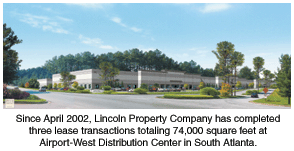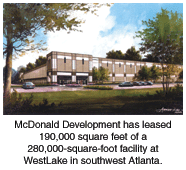HIGH VACANCIES PLAGUE OFFICE & INDUSTRIAL MARKETS
The unrelenting economic downturn has had a powerful impact on office
and industrial markets.
Julie Fritz
As the number of companies downsizing and going out of
business increases, building owners are suddenly finding themselves with
large amounts of space to lease. Industrial and office markets in particular
have been hard hit by corporate scandal, bankruptcies and rising vacancy
rates. Many building owners are spending a lot of time focusing on retaining
tenants while trying to close new deals. The amount of available sublease
space continues to rise, and owners are backfilling large blocks of space
with smaller tenants.
With the drop off in demand, the markets are “just depressing”
right now, according to one Southeast executive. Even Atlanta, historically
a prime location for new business and expansion, is now facing company
downsizing, closings and large amounts of vacant space.
Despite this grim picture, many developers are positive about the new
year. Available space is slowly being absorbed, prompting developers to
continue with new, sometimes speculative projects, many of which will
come on line this year.
Renewals
 One
indication the market isn’t doing too poorly is renewals, which are
up in most markets. “Many tenants don’t want to lose focus of
their current business operation or incur the costs that are involved
in planning a relocation unless they have to,” says Allen Aldridge,
vice president and regional manager of CMD Realty Investors’ Southeast
region. “So you’re seeing a much higher percentage of tenants
staying put, assuming that the current owner is competitive in the market,
which most are.” One
indication the market isn’t doing too poorly is renewals, which are
up in most markets. “Many tenants don’t want to lose focus of
their current business operation or incur the costs that are involved
in planning a relocation unless they have to,” says Allen Aldridge,
vice president and regional manager of CMD Realty Investors’ Southeast
region. “So you’re seeing a much higher percentage of tenants
staying put, assuming that the current owner is competitive in the market,
which most are.”
“Renewals are critical in today’s environment, and it can be
very competitive to try to retain a tenant that’s up for renewal,”
says Julian Brown, senior vice president of Lincoln Property Company.
“You’ve really got to offer a lot of concessions because the
tenant can move and get concessions from someone else.”
Sublease Space
There is still a large amount of sublease space on the market, which isn’t
a new thing. “We’ve started to see a trend in the increased
amount that companies are willing to pay to buy out those leases,”
says Aldridge. “Some companies are now paying up to 100 percent of
their outstanding lease obligations to make them go away. We had a recent
deal in South Florida with a credit tenant, a sizeable corporation that
had a 5,000-square-foot sublease with a year or year and a half remaining.”
The tenant recognized that the odds of leasing that space in the next
year and a half were minimal, and the amount of time that company would
spend attempting to lease the space would be more trouble than it was
worth. “They decided to just pay it off and move on — getting
rid of that space obligation,” he explains.
In terms of size of the deals, not many large tenants are looking for
space, Aldridge notes. “In fact, if you go down a list of national
companies or even regional companies, they’re all giving back space,”
he continues. “We’ve played a part in that. We took about 100,000
square feet back from SouthTrust Bank last year after they did a build-to-suit
operations center. We certainly don’t anticipate backfilling that
space with 100,000-square-foot users. We’ll have to fill it back
up with 5,000-, 10,000-, 15,000- and 20,000-square-foot users.”
Through discussions with Bill Weghorst of Insignia/ESG and other Atlanta
brokers, Aldridge has discovered that, while there is a great deal of
large block space available in Perimeter Center, there are few active
deals above 7,000 square feet. “That was just unheard of a couple
of years ago,” says Aldridge. “There would normally be a lot
of big block users down there. I think that’s going to continue,
and that’s going to make this harder. It’s going to take more
time and it’s going to make it more difficult to backfill the space
that’s currently vacant.”
Done Deals
 “Since
April 2002, we’ve signed about 241,000 square feet in leases [in
Atlanta], which is pretty good, considering some markets have had negative
absorption,” Brown notes. “We’re really excited about that.
In addition to the three leases at Airport-West, we closed two leases
in the Northeast submarket: a 65,000-square-foot deal with a company called
Infinite Dimensions, and a 102,000-square-foot lease with Climatic Corporation.”
Denton Shamburger, also of Lincoln, helped lease this space. “Since
April 2002, we’ve signed about 241,000 square feet in leases [in
Atlanta], which is pretty good, considering some markets have had negative
absorption,” Brown notes. “We’re really excited about that.
In addition to the three leases at Airport-West, we closed two leases
in the Northeast submarket: a 65,000-square-foot deal with a company called
Infinite Dimensions, and a 102,000-square-foot lease with Climatic Corporation.”
Denton Shamburger, also of Lincoln, helped lease this space.
The company signed a total of 74,000 square feet in leases in its Airport-West
Distribution Center, a speculative project totaling 287,990 square feet
in south Atlanta’s Airport submarket. After the company delivered
buildings 100 and 200 in April 2002, Bank of America signed a 30,000-square-foot
lease for its back office operations facility, Penske Logistics signed
30,000 square feet and Chick-fil-A took 14,000 square feet.
 “Most
of [our tenants] like the fact that Airport-West has great interstate
access,” says Brown. “That’s been a big attraction, and
I think that’s what’s been driving that whole South Fulton County
corridor. Costco, GE, Kellogg and Caterpillar and some other companies
have located there.” Airport-West is located within 5 miles of interstates
85, 285 and 75 and just minutes from Hartsfield International Airport. “Most
of [our tenants] like the fact that Airport-West has great interstate
access,” says Brown. “That’s been a big attraction, and
I think that’s what’s been driving that whole South Fulton County
corridor. Costco, GE, Kellogg and Caterpillar and some other companies
have located there.” Airport-West is located within 5 miles of interstates
85, 285 and 75 and just minutes from Hartsfield International Airport.
“We signed 400,000 square feet of leases in the fourth quarter of
2002, but it was a slow year,” says John McDonald, president of McDonald
Development Company. Slow or not, the firm continues to make deals and
is excited about success of some of its most recent projects.
Recent Developments
 In
2002, McDonald Development completed a 280,000-square-foot cross-dock
building at WestLake in southwest Atlanta. To date, the company has leased
190,000 square feet at the new facility: 115,000 square feet to Clean
Rite, a company that sells supplies to auto stores, and Kent Landsberg
leased 75,000 square feet. In
2002, McDonald Development completed a 280,000-square-foot cross-dock
building at WestLake in southwest Atlanta. To date, the company has leased
190,000 square feet at the new facility: 115,000 square feet to Clean
Rite, a company that sells supplies to auto stores, and Kent Landsberg
leased 75,000 square feet.
The company also delivered a building in Horizon Ridge, a park located
east of Atlanta in Gwinnett County. It is a 295,000-square-foot building
that is expandable to 624,000 square feet. “We anticipate having
one to two tenants; it will be distribution because of the cross-dock
nature, and we would anticipate 5 to 15 percent office,” says McDonald.
 “We
also completed a 272,000-square-foot cross-dock expandable to 1 million
square feet in our South Park development in Clayton County,” McDonald
continues. “We’ve leased 200,000 square feet of that building
to a retailer that’s moving into Atlanta.” “We
also completed a 272,000-square-foot cross-dock expandable to 1 million
square feet in our South Park development in Clayton County,” McDonald
continues. “We’ve leased 200,000 square feet of that building
to a retailer that’s moving into Atlanta.”
In addition to northeast Atlanta, which is strong because of sheer size
(it is Atlanta’s largest industrial submarket), McDonald and Brown
agree that the Airport submarket in south Atlanta is one of the strongest
markets in the city for industrial development. This is evidenced by Lincoln’s
Airport-West Distribution Center. The company broke ground on Airport-West
on Labor Day weekend 2001. A little over a week later the September 11
terrorist attacks occurred, slowing down the kick-off. “In spite
of that, we have been very fortunate,” says Brown. “We got three
good tenants in there pretty quickly. We have one other tract that we
can turn into three more buildings, but we won’t start that until
we get [the existing buildings] up to about 80 percent occupancy.”
“Activity has been fair on the south side [of Atlanta] in spite of
what the rest of the market has done, and we hope it will pick up with
the economy,” Brown adds. “A lot of that has been driven by
the expansion of the fifth runway at Hartsfield International Airport.”
One indication of this area’s strength is Oakmont Industrial Group’s
development plans. “Oakmont Industrial has contracted to buy the
48 acres directly across from us on Naturally Fresh Boulevard,” says
Brown. “I think that’s just another affirmation that this area’s
going to continue to grow.”
Buy or Sell?
Many companies, including CMD Realty Investors, have what would seem to
be an unusual problem: money to invest but nothing to buy. Well, nothing
worth buying, anyway.
“We currently have about $300 million to invest, but the opportunities
are very difficult to find right now,” says Aldridge. “There
is a very wide gap in the available properties that are out there and
the prices that they trade for. Assets that are leased up well into the
future are trading at historically low cap rates and extremely high values.”
CMD is currently selling some of its well-positioned Southeast assets.
The properties are leased out long-term with good credit tenants. “People
are paying a lot of money for that product right now,” says Aldridge.
“On the flip side, they aren’t paying that much money for the
opportunity properties, and therefore there are not many opportunity properties
for sale. Still, there’s not a lot of trading, and it’s very
difficult to try to place all the capital that’s currently out there.
I think you’re going to see increased pressure to try to place that
capital in 2003, but it’s still going to be a difficult job, and
we’re going to be in that tight boat.”
McDonald explains the mindset of many companies in the market today: “Everyone
is trying to maintain their existing tenants. Fully leased buildings have
low cap rates today. People are willing to pay more for them because there
are less of them. If a building is less than 85 percent leased, the buyers
want to bargain.”
©2003 France Publications, Inc. Duplication
or reproduction of this article not permitted without authorization
from France Publications, Inc. For information on reprints of
this article contact Barbara
Sherer at (630) 554-6054.
|
